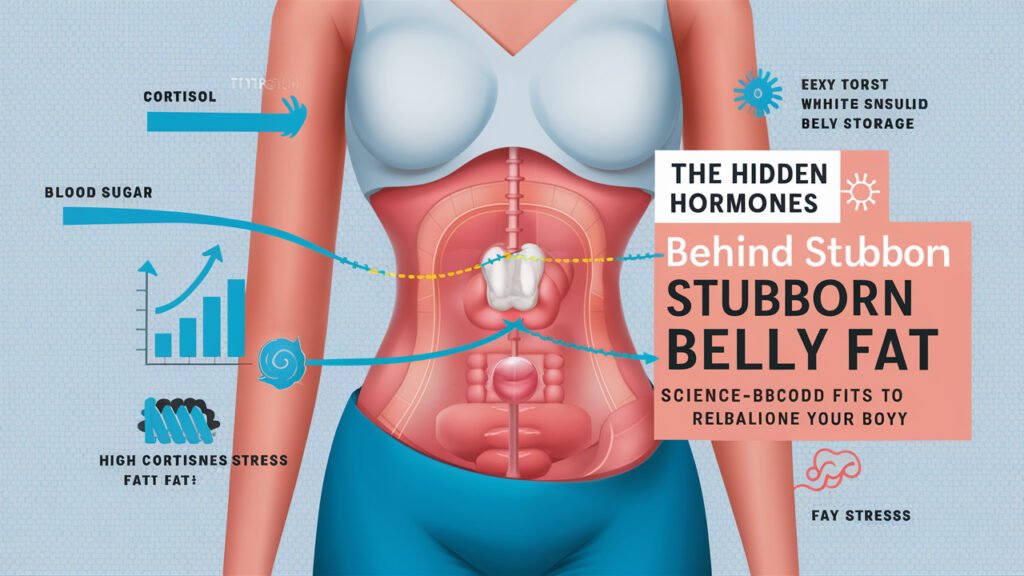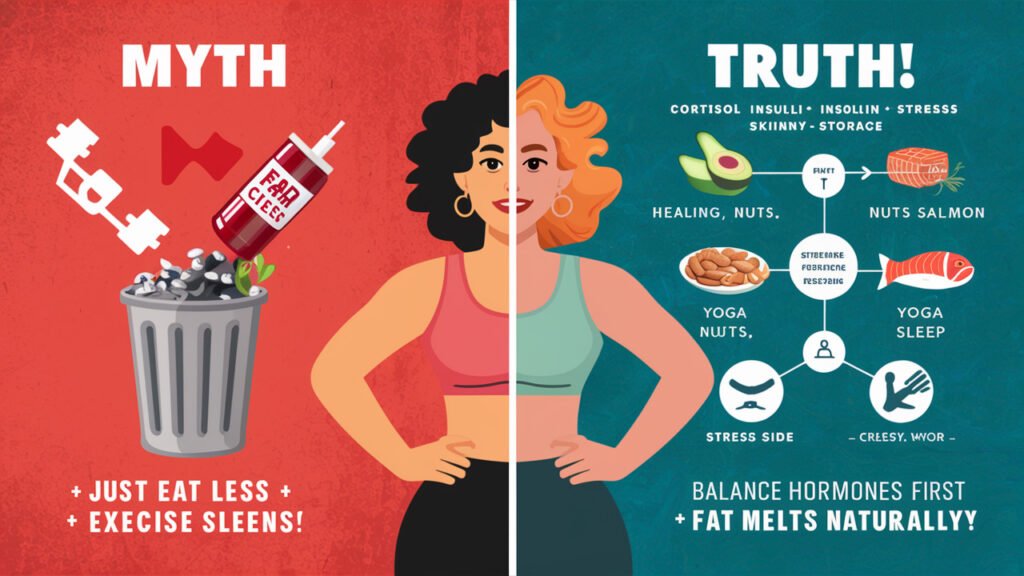How to Fix Hormonal Belly Fat: Doctor-Approved Tips
I’ve struggled with stubborn weight gain around my midsection, and I’m not alone. Many of us experience this frustrating issue, which can be attributed to hormonal imbalances. When our hormone levels are out of balance, it can lead to an accumulation of belly fat, making it challenging to achieve our desired weight.
Simply cutting calories isn’t enough; we need to address the underlying causes of our weight gain. This is where understanding the role of cortisol and stress comes into play. By recognizing the impact of these factors on our body and overall health, we can begin to tackle the root causes of our belly fat.
Key Takeaways
- Understanding the hormonal mechanisms behind belly fat accumulation is crucial for effective treatment.
- Addressing lifestyle, nutrition, and medical factors is essential for fixing hormonal belly fat.
- Stress and cortisol levels play a significant role in weight gain around the midsection.
- A comprehensive approach is necessary to tackle stubborn weight gain.
- Doctor-approved tips can help you achieve your desired weight and improve overall health.
Understanding Hormonal Belly Fat
Understanding the root cause of hormonal belly fat is crucial for effective weight management. Hormonal belly fat refers to the accumulation of fat around the abdominal area, primarily caused by hormonal imbalances rather than simply excess calorie consumption.
What Is Hormonal Belly Fat?
Hormonal belly fat is often associated with visceral fat, which is the fat that accumulates around the organs. This type of fat is metabolically active and can produce compounds that further disrupt hormone balance. Unlike subcutaneous fat, which is the fat under the skin, visceral fat is more dangerous to overall health.
For instance, women experiencing postpartum weight loss challenges may find it helpful to explore safe workouts and products, as discussed in resources like this article.
How Hormonal Belly Fat Differs from Regular Fat
Hormonal belly fat differs from regular fat in its characteristics and impact on the body. It is often resistant to traditional weight loss methods like calorie restriction and regular exercise. The appearance of hormonal belly fat can be distinct, with a more pronounced accumulation around the abdominal area.
| Characteristics | Hormonal Belly Fat | Regular Fat |
|---|---|---|
| Location | Primarily around organs (visceral) | Under the skin (subcutaneous) |
| Metabolic Activity | Metabolically active | Less metabolically active |
| Response to Weight Loss Methods | Resistant to traditional methods | Responsive to diet and exercise |
Signs You Have Hormonal Belly Fat
Understanding the signs of hormonal belly fat is crucial for effective weight management. Hormonal belly fat can manifest in different ways, making it essential to recognize the indicators that distinguish it from regular fat.
Physical Indicators of Hormonal Imbalance
One of the primary signs of hormonal belly fat is disproportionate weight gain in the midsection, despite maintaining a relatively normal weight overall. This type of fat often appears suddenly or develops despite healthy eating and exercise habits. The pattern of fat distribution can also be a clue; an “apple shape” body type, where fat accumulates around the abdomen, can indicate hormonal influences, particularly related to cortisol and insulin resistance.

Common Symptoms Beyond Weight Gain
Beyond the physical appearance of belly fat, there are other symptoms that can indicate hormonal imbalances. These include fatigue, mood changes, and sleep disturbances. Skin changes, hair loss, or irregular menstrual cycles can also be connected to the same hormonal issues causing belly fat. Additionally, increased hunger, cravings, or changes in energy levels throughout the day can signal hormonal problems, particularly related to blood sugar and insulin resistance.
Recognizing these signs and symptoms can help you address the underlying hormonal imbalances and take steps towards achieving a healthier body composition and overall health.
The Hormones That Cause Belly Fat
Hormones such as cortisol, insulin, and sex hormones significantly impact belly fat storage. Understanding how these hormones interact with our body is crucial for addressing hormonal belly fat.
Cortisol: The Stress Hormone Connection
Cortisol, often referred to as the stress hormone, plays a significant role in belly fat accumulation. When we’re under stress, our body releases cortisol, which prepares our body to respond to the stressor. However, chronically elevated cortisol levels can lead to increased fat storage around the abdominal area. This is because cortisol promotes the redistribution of fat, particularly from the periphery to the central part of the body.
Insulin and Blood Sugar Imbalance
Insulin resistance is another key factor in hormonal belly fat. When our cells become resistant to insulin, our body produces more insulin to compensate, leading to higher insulin levels. High insulin levels promote fat storage, particularly in the abdominal area. This is because insulin encourages the storage of glucose in the form of fat. According to Mayo Clinic, insulin resistance is a significant contributor to belly fat.

Sex Hormones: Estrogen and Testosterone
Sex hormones, including estrogen and testosterone, also influence fat distribution. In women, estrogen helps distribute fat to the hips and thighs, while testosterone promotes fat storage around the abdominal area. Imbalances in these hormones, such as those experienced during menopause or due to certain medical conditions, can lead to increased belly fat.
Thyroid Hormones and Metabolism
Thyroid hormones play a crucial role in regulating our metabolism. Hypothyroidism, or an underactive thyroid, can lead to a slower metabolism, resulting in weight gain and difficulty losing belly fat. Ensuring optimal thyroid function is essential for maintaining a healthy weight.
| Hormone | Effect on Belly Fat |
|---|---|
| Cortisol | Increases fat storage around the abdominal area |
| Insulin | Promotes fat storage, particularly in the abdominal area |
| Estrogen and Testosterone | Influence fat distribution; imbalances can lead to increased belly fat |
| Thyroid Hormones | Regulate metabolism; hypothyroidism can lead to weight gain |
How to Fix Hormonal Belly Fat – Doctor-Approved Tips
To effectively tackle hormonal belly fat, it’s crucial to follow doctor-approved tips that address the root causes of hormone imbalances. A comprehensive approach involves medical testing, consulting with healthcare providers, and creating a personalized plan tailored to individual needs.
Medical Testing to Identify Hormone Imbalances
Proper medical testing is essential to identify specific hormone imbalances contributing to belly fat. This may include blood tests to measure hormone levels, saliva tests to assess cortisol and other hormone imbalances, and urine tests to evaluate hormone metabolism. These tests help healthcare providers understand the underlying causes of hormonal belly fat.

When to Consult a Healthcare Provider
If you’re experiencing persistent belly fat despite making lifestyle changes, it’s time to consult a healthcare provider. Specialists such as endocrinologists, functional medicine practitioners, and naturopathic doctors can offer expert guidance. They will assess your medical history, family history, and current symptoms to determine the best course of action.
Creating a Personalized Hormone-Balancing Plan
A personalized hormone-balancing plan typically combines medical interventions, dietary changes, exercise recommendations, and lifestyle modifications. Healthcare providers will interpret test results and develop a tailored strategy to address hormone imbalances. Regular monitoring and adjustments to the treatment plan are crucial to achieving and maintaining hormone balance and reducing belly fat.
By following these doctor-approved tips and working closely with a healthcare provider, individuals can effectively address hormonal belly fat and improve their overall health.
Nutrition Strategies to Balance Hormones
Achieving hormone balance through nutrition is crucial for reducing belly fat and improving overall health. A well-structured diet can help regulate hormones, leading to a healthier weight and improved well-being.
Foods That Support Hormone Balance
Certain foods can significantly support hormone balance by providing essential nutrients. Foods rich in omega-3 fatty acids, such as salmon and sardines, help reduce inflammation and support hormone production. Additionally, foods high in fiber like vegetables, fruits, and whole grains aid in regulating blood sugar levels and promoting healthy insulin function.
Antioxidant-rich foods, including berries, leafy greens, and other fruits and vegetables, help protect against oxidative stress, which can disrupt hormone balance. Adequate protein intake is also crucial as it affects hormones like insulin and glucagon, supporting overall hormone balance.
| Food Group | Examples | Hormone Benefit |
|---|---|---|
| Omega-3 Rich Foods | Salmon, Sardines, Walnuts | Reduces inflammation, supports hormone production |
| Fiber-Rich Foods | Vegetables, Fruits, Whole Grains | Regulates blood sugar, promotes healthy insulin function |
| Antioxidant-Rich Foods | Berries, Leafy Greens, Other Fruits and Vegetables | Protects against oxidative stress |
Foods to Avoid for Hormone Health
Just as certain foods can support hormone balance, others can disrupt it. Refined sugars and highly processed foods can lead to insulin resistance, a key factor in hormonal belly fat. Trans fats found in processed and fried foods can also negatively impact hormone balance by promoting inflammation.
Avoiding or minimizing these foods can help maintain hormone health. Additionally, limiting alcohol consumption is advisable as it can affect hormone levels and contribute to belly fat.
Meal Timing and Hormone Regulation
The timing and frequency of meals can also impact hormone regulation. Practices like intermittent fasting have been shown to improve insulin sensitivity and support hormone balance for some individuals. However, it’s essential to find a meal timing strategy that works best for each person.
Eating regular, balanced meals can help maintain stable blood sugar levels and support overall hormone health. It’s also crucial to listen to your body and adjust your meal timing accordingly.
The Role of Exercise in Reducing Hormonal Belly Fat
Exercise plays a crucial role in reducing hormonal belly fat by influencing hormone levels and improving overall body composition. Regular physical activity can help mitigate the effects of hormonal imbalances that lead to fat accumulation around the abdominal area.
Different types of exercise have distinct impacts on hormone regulation and fat loss. Understanding these differences is key to creating an effective exercise plan.
HIIT Workouts for Hormone Balance
High-Intensity Interval Training (HIIT) has been shown to effectively reduce cortisol levels and improve insulin sensitivity, both of which are crucial for reducing hormonal belly fat. HIIT involves short bursts of intense exercise followed by brief periods of rest. This type of training not only burns calories during the workout but also boosts metabolism for hours afterward.

Strength Training to Boost Metabolism
Strength training is another critical component of an exercise plan aimed at reducing hormonal belly fat. By building muscle mass, strength training can significantly boost metabolism, helping the body burn more calories at rest. This can lead to a reduction in body fat, including around the abdominal area.
Low-Impact Exercise Options
For individuals with joint issues or those who are new to exercise, low-impact options such as yoga, Pilates, or brisk walking can be effective alternatives. These exercises can help improve hormone balance and reduce belly fat without putting excessive strain on the joints.
It’s also important to consider the role of recovery in an exercise plan. Overtraining can negatively impact hormone balance, leading to increased cortisol levels and potentially more belly fat. Ensuring adequate rest and recovery time is crucial for maximizing the benefits of exercise on hormonal belly fat.
Stress Management Techniques for Cortisol Control
To combat hormonal belly fat, it’s essential to adopt effective stress management techniques. Chronic stress leads to increased cortisol levels, which can cause weight gain, particularly around the belly area. By managing stress, you can help regulate cortisol and support overall health.
Meditation and Mindfulness Practices
Meditation and mindfulness have been shown to reduce cortisol levels and improve overall well-being. Regular practice can help you manage stress more effectively. You can start with guided meditation sessions available online or through apps like Headspace.
Breathing Exercises for Immediate Stress Relief
Simple breathing exercises can provide immediate stress relief. Try inhaling deeply through your nose, holding your breath for a few seconds, and exhaling slowly through your mouth. This technique can help manage cortisol spikes and reduce stress.
Lifestyle Changes to Reduce Chronic Stress
Making lifestyle changes such as setting boundaries, prioritizing self-care, and improving time management can significantly reduce chronic stress. Engaging in enjoyable activities and having adequate leisure time also helps balance cortisol levels. For more tips on managing hormonal belly fat, visit Parsley Health’s blog.
Sleep Optimization for Hormone Regulation
Sleep plays a significant role in hormone regulation, impacting body fat and overall health. During sleep, various hormonal processes occur that influence metabolism, growth, and fat storage. Poor sleep quality can disrupt these processes, leading to hormonal imbalances that may result in weight gain and increased belly fat.
How Sleep Affects Hormone Balance
Sleep deprivation directly affects hormone regulation, particularly for cortisol, insulin, and growth hormone. When sleep is inadequate, cortisol levels can rise, promoting fat storage around the belly. Insulin sensitivity is also impaired, potentially leading to weight gain. Moreover, growth hormone, which is crucial for muscle repair and metabolism, is primarily released during deep sleep cycles.

Creating a Sleep Routine for Better Hormone Health
To optimize sleep for hormone regulation, establishing a consistent sleep schedule is crucial. Going to bed and waking up at the same time daily helps regulate the body’s internal clock, supporting hormonal balance. Additionally, creating a sleep-conducive environment by reducing light exposure, maintaining a comfortable temperature, and minimizing noise can improve sleep quality. Avoiding digital devices, caffeine, and alcohol before bedtime also helps in achieving better sleep and, consequently, hormone balance.
Natural Supplements for Hormone Balance
Incorporating specific natural supplements into your regimen may help support hormone balance and improve overall health.
Adaptogenic Herbs for Stress and Cortisol
Adaptogenic herbs like ashwagandha and rhodiola have been shown to help balance cortisol levels and reduce stress responses. These herbs work by supporting the body’s natural response to stress, potentially leading to improved hormone balance and reduced belly fat.

Vitamins and Minerals for Hormone Support
Certain vitamins and minerals play crucial roles in hormone production and regulation. Vitamin D, magnesium, and zinc are particularly important for maintaining healthy hormone levels. Omega-3 fatty acids can also help reduce inflammation, supporting overall hormone balance.
Safety Considerations When Using Supplements
While natural supplements can be beneficial, it’s essential to consult with a healthcare provider before starting any new regimen. This ensures that the supplements won’t interact with medications or exacerbate underlying health conditions.
Special Considerations for Different Life Stages
The impact of hormonal belly fat varies across different life stages, necessitating tailored approaches for effective management. As individuals progress through various stages of life, hormonal fluctuations can significantly influence body composition, particularly around the belly area.
Hormonal Belly Fat During Perimenopause and Menopause
During perimenopause and menopause, women often experience significant hormonal changes that can lead to increased belly fat. The decline in estrogen levels is particularly associated with fat redistribution to the abdominal area. Studies have shown that this shift in body composition can increase the risk of various health conditions, including cardiovascular disease and diabetes. To manage hormone-related weight changes, women in midlife can benefit from a combination of dietary changes, such as increasing intake of phytoestrogens, and lifestyle modifications, including regular exercise and stress management techniques.

Addressing Hormonal Belly Fat in Men
In men, declining testosterone levels with age can contribute to increased belly fat. This condition, often referred to as hypogonadism, can lead to changes in body composition, reduced muscle mass, and increased fat around the abdominal area. Hormonal belly fat may present differently in men versus women, often resulting in a more visceral fat accumulation. Strategies for addressing hormonal belly fat in men include strength training to boost testosterone levels naturally, dietary adjustments to support hormone balance, and stress management techniques to control cortisol levels.
By understanding these gender-specific differences and life-stage considerations, individuals can develop more effective, personalized plans to manage hormonal belly fat.
Tracking Progress and Adjusting Your Approach
Tracking your progress is vital to understanding whether your efforts to reduce hormonal belly fat are working. Traditional methods like scale weight alone may not be effective, as they don’t differentiate between fat loss and muscle loss or water weight.
More effective metrics include waist circumference, body composition measurements, and how clothes fit. It’s also crucial to track non-weight indicators like energy levels, sleep quality, and mood.
Assess your progress every few weeks, and be patient as hormonal balance and weight loss take time. If you’re not seeing results, it may be time to adjust your approach. Strategies for overcoming plateaus include changing your exercise routine or consulting with a healthcare provider.
Conclusion
By adopting a holistic approach to hormone balance, you can say goodbye to stubborn belly fat. Addressing hormonal imbalances through medical testing, nutrition, exercise, and stress management can lead to sustainable weight loss and overall health improvement. It’s essential to work with a doctor to create a personalized plan. Balancing hormones like insulin and cortisol can reduce weight gain and improve overall wellbeing. With consistency and patience, you can achieve a healthier body and reduce the risk of obesity-related conditions.
FAQ
What is the main cause of hormonal belly fat?
Can stress really contribute to belly fat?
Are there specific foods that can help balance hormones and reduce belly fat?
How does sleep affect hormonal belly fat?
Is exercise effective in reducing hormonal belly fat?
Can supplements help with hormone balance and belly fat?
editor's pick
latest video
news via inbox
Nulla turp dis cursus. Integer liberos euismod pretium faucibua




